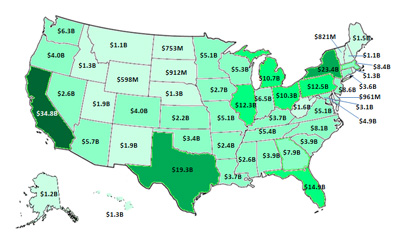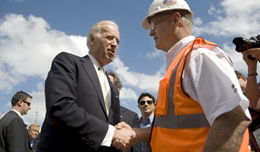Chapter 2: A State View on Recovery
As mentioned in Chapter 1 above, the initial concentration of ARRA funds went out through payments to states and individuals. Figure 19 below shows the latest amount of funding obligated on a per state basis.

Figure 19 Obligations per state20
Highlighted Projects:
Funding aside, the real story to be seen at the state level is the projects that are underway, changing the face of the country and putting people to work. Highlighted below are just some of the over 55,000 projects currently approved that are supported by ARRA funding. These projects provide a representative sample of the entire universe of ARRA projects. However, ARRA funded projects are not limited to just these types. These projects were selected as they will have a lasting impact on our nation's infrastructure and economy.
California
Solyndra, Inc: Solyndra, Inc. received a loan guarantee in September 2009 to finance up to $535 million to build a factory that will manufacture innovative cylindrical solar photovoltaic cells. The annual output of solar panels from the first phase of the expansion will go to generating the energy equivalent of powering 24,000 homes a year. Construction of the new site has already created 541 direct jobs. Solyndra estimates that the new plant will initially create 3,000 construction jobs and lead to as many as 1,000 permanent jobs once the facility opens. The first solar panels are scheduled to come off the line in October this year.
California DOT and HSR Authority, High Speed Rail: The California Department of Transportation and the California High Speed Rail Authority were awarded $2.35 billion on January 28, 2010 for the construction of a new, electrically powered high-speed rail system of 800 miles with over 300 trains per day. Phase I calls for a 520-mile system connecting Anaheim and Los Angeles through the Central Valley to San Francisco by 2020, while Phase II would extend the system north to Sacramento and south to San Diego by 2026. Trains will reach speeds of 220mph, providing a travel time between Los Angeles and San Francisco of less than 2 hours 40 minutes, compared to 6 hours by car. At full build-out, California expects up to 100 million passengers per year, making it one of the busiest passenger rail lines in the world. Survey work has already begun.
Florida
Florida DOT, Expressway Connector Project: The Florida Department of Transportation has received a $105 million grant on October 30, 2009 to build the I-4/Selmon Expressway Connector, a new toll road that will connect Interstate 4 to the Selmon Expressway. This road will provide commercial trucks direct access to the Port of Tampa and make the movement of goods more efficient. In building this new road, Recovery Act dollars are helping create a safer, more efficient means of transportation for visitors, commuters and commerce in the area.
Kansas
Rural Telephone Service Co., Inc.: Rural Telephone Service Co., Inc. has received a $51.6 million loan and a $49.5 million grant in Recovery Act money on January 25, 2010 from the U.S. Department of Agriculture, Broadband Initiatives Program. Rural Telephone Service Co., Inc. has already hired four new employees, and engineering and electronics firms associated with the project have created or saved 28 jobs. The project will provide broadband service in an area of western Kansas that is 99.5 percent unserved or underserved, and covers 21 communities and 26 rural areas spanning over 4,600 square miles. It will provide the infrastructure required for economic stability, education and healthcare.
Massachusetts
Massachusetts Clean Energy Center: The Massachusetts Clean Energy Center (CEC) in Boston received $24.7 million in Recovery Act funding from the Department of Energy. The CEC will design, construct, and operate the Large Wind Turbine Blade Test Facility—an advanced blade testing facility capable of testing blades up to at least 70 meters in length on three test stands. CEC has already reported the creation of 30 jobs in management, design, engineering and construction, and will use Recovery Act funds to accelerate the project schedule in anticipation of increasing domestic growth and continued large-scale domestic deployment of wind energy.
New Bedford Harbor, Superfund Site Cleanup: The New Bedford Harbor Superfund site in New Bedford, Massachusetts received $30 million in Recovery Act funds on April 15, 2009 to accelerate the ongoing cleanup of an urban tidal estuary with sediments that are highly contaminated with polychlorinated biphenyls (PCBs) and heavy metals. The project has already created 82 new jobs, and will help facilitate the City’s plans to develop shoreline public access and wetland restoration in the upper and lower harbor areas. Since initiating ARRA-funded work in June, EPA has dredged approximately 25,000 cubic yards of contaminated sediments.
Michigan
A123, EERE/Battery Manufacturing and Electric Drive Component Grants: A123 is using its $249 million award to build battery factories in Livonia, Romulus and Brownstown, Michigan. The company, which received its award on December 3, 2009, has already reported the creation of 90 new jobs, and expects to hire over 3,000 people by 2012. A123 has partnerships with several well known carmakers, and the company's first large scale plant is a great story of American innovation. The company started as a spinoff from MIT's labs in 2001, with help from a $100,000 DOE Small Business Innovation Research grant. Since its inception, A123's small, five-person operation has grown to 1,600 employees worldwide. In 2009, A123 held a successful initial public offering and raised over $300 million.
New York
ION Hold Co. LLC, Broadband Initiative: ION Hold Co. LLC was awarded $39.7 million in December 2009 to implement a rural broadband infrastructure project. ION will build 10 new segments of fiber optic middle mile broadband infrastructure serving more than 70 rural communities in upstate New York and parts of Pennsylvania and Vermont. The project will enable wired and wireless last mile service providers to make broadband more readily available to 250,000 households and 38,000 businesses, and extend middle mile infrastructure to low-income rural areas with higher than average unemployment.
Ohio
Ohio DOT, Nelsonville Bypass Project: The Ohio Department of Transportation has received $138 million for the Nelsonville Bypass project which is the largest infusion of Recovery Act funds Ohio has received for a single project. The Ohio DOT has already broken ground on the new 8.5 mile, four-lane highway to divert freight traffic away from town. The project is already on its way to supporting 305 jobs. The Nelsonville Bypass will take trucks off the local roads, which will allow the 620,000 trucks that travel this route every year to pass through more quickly and efficiently. The new bypass, which is the final upgrade of the U.S. 33 corridor in southeast Ohio, will also provide the needed transportation infrastructure to support current and future commerce to Appalachia.
Oregon
Cascade Sierra Solutions, EPA Grant: Cascade Sierra Solutions (CSS), based in Coburg, Oregon, has received a $9 million SmartWay Clean Diesel Innovative Finance Program Grant from the Environmental Protection Agency on July 29, 2009. CSS is a non-profit organization dedicated to saving fuel and reducing emissions from diesel engines, and will use this grant to fund the financing of truck replacement and retrofit projects, targeting heavy-duty diesel trucks. CSS reports that it has been able to create or save 80 jobs using the EPA grant. According to CSS, this lease program for trucking companies it has extended to drivers would not have been possible without ARRA money.
Pennsylvania
Research on Genomic Function, National Institutes of Health: Pennsylvania State University was awarded $750,000 in October 2009 to conduct research on genome function. Principal Investigator Ross Hardison’s study is one of many research projects across the nation dedicated to using the tools and technologies produced by the Human Genome Project to better understand biology and improve human health. Fueled by $1 billion in new funding, these efforts will allow researchers to make quantum leaps in studying the genomic changes linked to cancer, cardiovascular disease, autism and many other health conditions — paving the way for new strategies to detect, treat and prevent disease.
Fidelis Construction, Coatesville VA Medical Center: Fidelis Construction, a veteran-owned business, has received a $2.3 million Recovery Act contract on September 17, 2009 for a pharmacy renovation project at the VA Medical Center in Coatesville, Pennsylvania. The company has already begun to hire new employees and estimates that the project will create 40 jobs. The goal of the renovation is to improve the efficiency and privacy of a hospital pharmacy that serves around 22,000 veterans.
South Carolina
Itron, Inc, Advanced Energy Manufacturing Tax Credit: Itron, Inc was selected to receive a $5 million renewable energy manufacturing tax credit on January 8, 2010 that will allow it to expand its smart grid component manufacturing facility in South Carolina. The company recently expanded its North American facilities that produce circuit boards and "smart" meters to accommodate increasing orders for smart grid components to supply recipients of the Smart Grid Investment Grant and demonstration projects. Itron is actively hiring new employees at all of their North American facilities, and has currently increased its number of employees in the South Carolina facility to 900 full and part-time workers. The re-equipped facility will allow an annual production capacity of 4 million meters, and Itron estimates that a single year's output will be able to reduce electricity use by approximately 1.7 million MWh per year.
Texas
Fort Bliss, Wounded Warriors Unit: Fort Bliss was awarded $51 million of DOD’s Recovery Act funding on May 1, 2009 to complete a Wounded Warriors Unit for recuperating injured soldiers and their families in El Paso, Texas. The project is expected to benefit thousands of soldiers and their families over the lifetime of the facility. The project has already created or saved 45 jobs, and will employ more than 50 staff upon completion. The three-building complex includes a 140,000-square-foot barracks capable of housing 232 injured soldiers. The project also includes a soldier and family assistance center, and a warrior care headquarters and administrative building. Construction of the complex has already begun.
20 Data as of January 29, 2010. Source: Financial and Activity Report
THE RECOVERY BILL
The American Recovery and Reinvestment Act is a strategic and significant investment in our country’s future. The Act will save and create jobs immediately while also laying the foundation for a robust and sustainable 21st century economy by modernizing our health care, improving our schools, modernizing our infrastructure, and investing in the clean energy technologies of the future.

